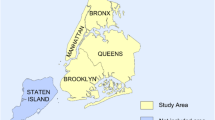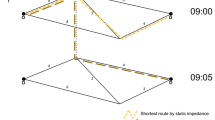Abstract
Accessibility is essentially a dynamic concept. However, most studies on urban accessibility take a static approach, overlooking the fact that accessibility conditions change dramatically throughout the day. Due to their high spatial and temporal resolution, the new data sources (Big Data) offer new possibilities for the study of accessibility. The aim of this paper is to analyse urban accessibility considering its two components –the performance of the transport network and the attractiveness of the destinations– using a dynamic approach using data from TomTom and Twitter respectively. This allows us to obtain profiles that highlight the daily variations in accessibility in the city of Madrid, and identify the influence of congestion and the changes in location of the population. These profiles reveal significant variations according to transport zones. Each transport zone has its own accessibility profile, and thus its own specific problems, which require solutions that are also specific.






Similar content being viewed by others
Notes
Transport zones typically consider the following criteria: compatibility with other administrative divisions, homogeneity in their land use and/or population composition, correspondence with the natural catchment’s area of transport, etc. (Ortúzar and Willumsen 2011). Of them, the internal homogeneity within each zone is of especial interest for our study. Tweeters leave a particular temporal footprint on each land use, thus reflecting the daily variation of the use of each land use. For example, university campuses are very active in the morning, while retail and leisure areas are more active in the evening. The advantage of transport zones over other zones is that they are big enough to contain a representative number of tweeters every 15 min while preserving the above-mentioned land use homogeneity, which would become blurred in other zones (i.e. grid cells would contain a land use mixture).
Longley et al. (2015) report that these three days of the week have a very similar tweet profile, and represent the average working day, while Monday and Friday have specific profiles influenced by the proximity of Sunday and Saturday respectively.
This study uses Madrid official transport zones delimitation, which follows the criteria explained in previous footnote 1. There are 1171 transport zones in the study area.
References
Aziz HMA, Ukkusuri SV, Zhan X (2016) Determining the impact of personal mobility carbon allowance schemes in transportation networks. Netw Spat Econ. doi:10.1007/s11067-016-9334-x
Boisjoly G, El-Geneidy A (2016) Daily fluctuations in transit and job availability: a comparative assessment of time-sensitive accessibility measures. J Transp Geogr 52:73–81. doi:10.1016/j.jtrangeo.2016.03.004
Bruno G, Genovese A (2012) A spatial interaction model for the representation of the mobility of university students on the Italian territory. Netw Spat Econ 12:41–57. doi:10.1007/s11067-010-9142-7
Chen A, Yang C, Kongsomsaksakul S, Lee M (2007) Network-based acessibility measures for vulnerability analysis of degradable transportation networks. Netw Spat Econ 7:241–256. doi:10.1007/s11067-006-9012-5
Ciuccarelli P, Lupi G, Simeone L (2014) Visualizing the Data City, First. Springer International Publishing, Cham. http://www.springer.com/la/book/9783319021942. Accessed 27 Apr 2017
Dewulf B, Neutens T, Vanlommel M et al (2015) Examining commuting patterns using floating car data and circular statistics: exploring the use of new methods and visualizations to study travel times. J Transp Geogr 48:41–51. doi:10.1016/j.jtrangeo.2015.08.006
Farber S, Morang MZ, Widener MJ (2014) Temporal variability in transit-based accessibility to supermarkets. Appl Geogr 53:149–159. doi:10.1016/j.apgeog.2014.06.012
Fielbaum A, Jara-Diaz S, Gschwender A (2016) A parametric Description of cities for the normative analysis of transport systems. Netw Spat Econ. doi:10.1007/s11067-016-9329-7
Geurs KT, van Wee B (2004) Accessibility evaluation of land-use and transport strategies: review and research directions. J Transp Geogr 12:127–140. doi:10.1016/j.jtrangeo.2003.10.005
Geurs KT, De Montis A, Reggiani A (2015) Recent advances and applications in accessibility modelling. Comput Environ Urban Syst 49:82–85. doi:10.1016/j.compenvurbsys. 2014.09.003
Geurs KT, Patuelli R, Dentinho TP (2016) Accessibility, Equity and Efficiency: Challenges for Transport and Public Services. Edward Elgar Publishing Limited
Grauwin S, Sobolevsky S, Moritz S, et al (2015) Towards a comparative science of cities: using mobile traffic records in New York, London, and Hong Kong. In: Helbich M, Jokar Arsanjani J, Leitner M (eds) Computational approaches for urban environments, First. Springer International Publishing, pp 363–387
Jäppinen S, Toivonen T, Salonen M (2013) Modelling the potential effect of shared bicycles on public transport travel times in greater Helsinki: an open data approach. Appl Geogr 43:13–24. doi:10.1016/j.apgeog.2013.05.010
Jiang B, Ma D, Yin J, Sandberg M (2016) Spatial distribution of City tweets and their densities. Geogr Anal 48:337–351. doi:10.1111/gean.12096
Kaddoura I, Kröger L, Nagel K (2016) User-specific and dynamic internalization of road traffic noise exposures. Networks Spat Econ :1–20. doi: 10.1007/s11067-016-9321-2
Lenormand M, Picornell M, Cantú-Ros OG et al (2014) Cross-checking different sources of mobility information. PLoS One 9:30–38. doi:10.1371/journal.pone.0105184
Longley PA, Adnan M, Lansley G (2015) The geotemporal demographics of twitter usage. Environ Plan A 47:465–484. doi:10.1068/a130122p
Louail T, Lenormand M, García O et al (2014) From mobile phone data to the spatial structure of cities. Sci Rep 4:5276. doi:10.1038/srep05276
Martin D, Wrigley H, Barnett S, Roderick P (2002) Increasing the sophistication of access measurement in a rural healthcare study. Heal Place 8:3–13. doi:10.1016/S1353-8292(01)00031-4
Martin D, Jordan H, Roderick P (2008) Taking the bus: incorporating public transport timetable data into health care accessibility modelling. Environ Plan A 40:2510–2525. doi:10.1068/a4024
Mascia M, Hu S, Han K, et al (2016) Impact of traffic management on black carbon emissions: a microsimulation study. Networks Spat Econ :1–23. doi: 10.1007/s11067-016-9326-x
Møller-Jensen L, Kofie RY, Allotey ANM (2012) Measuring accessibility and congestion in Accra. Nor Geogr Tidsskr - Nor J Geogr 66:52–60. doi:10.1080/00291951.2011.644322
Moya-Gómez B, García-Palomares JC (2015) Working with the daily variation in infrastructure performance on territorial accessibility. The cases of Madrid and Barcelona. Eur Transp Res Rev 7:1–13. doi:10.1007/s12544-015-0168-2
Murthy D (2013) Twitter: social communication in twitter age, first. John Wiley & Sons, Cambridge
Netto VM, Pinheiro M, Meirelles JV, Leite H (2015) Digital footprints in the cityscape: finding networks of segregation through big data. In: International Conference on Location-Based Social Media Data. Athens, pp 1–15
Ortúzar JD, Willumsen LG (2011) Modelling transport, 4th edn. John Wiley & Sons, West Sussex
Owen A, Levinson DM (2015) Modeling the commute mode share of transit using continuous accessibility to jobs. Transp Res Part A Policy Pract 74:110–122. doi:10.1016/j.tra.2015.02.002
Páez A, Moniruzzaman M, Bourbonnais PL, Morency C (2013) Developing a web-based accessibility calculator prototype for the greater Montreal area. Transp Res Part A Policy Pract 58:103–115. doi:10.1016/j.tra.2013.10.020
Ratti C, Frenchman D, Pulselli RM, Williams S (2006) Mobile landscapes: using location data from cell phones for urban analysis. Environ Plan B Plan Des 33:727–748. doi:10.1068/b32047
Reades J, Calabrese F, Ratti C (2009) Eigenplaces: Analysing cities using the space - time structure of the mobile phone network. Environ Plan B Plan Des 36:824–836. doi:10.1068/b34133t
Reggiani A, Martín JC (2011) Guest editorial: new Frontiers in accessibility modelling: an introduction. Netw Spat Econ 11:577–580. doi:10.1007/s11067-011-9155-x
Reggiani A, Bucci P, Russo G (2011) Accessibility and network structures in the German commuting. Netw Spat Econ 11:621–641. doi:10.1007/s11067-010-9149-0
Salas-Olmedo MH, Rojas-Quezada C (2016) Mapping mobility patterns to public spaces in a medium-sized city using geolocated tweets. arXiv, Phys Soc 10
Shelton T, Poorthuis A, Zook M (2015) Social media and the city: rethinking urban socio-spatial inequality using user-generated geographic information. Landsc Urban Plan 142:198–211. doi:10.1016/j.landurbplan.2015.02.020
Sweet MN (2014) Do firms flee traffic congestion? J Transp Geogr 35:40–49. doi:10.1016/j.jtrangeo.2014.01.005
Sweet MN, Harrison CJ, Kanaroglou PS (2015) Gridlock in the greater Toronto area: its geography and intensity during key periods. Appl Geogr 58:167–178. doi:10.1016/j.apgeog.2015.01.011
Vandenbulcke G, Steenberghen T, Thomas I (2009) Mapping accessibility in Belgium: a tool for land-use and transport planning? J Transp Geogr 17:39–53. doi:10.1016/j.jtrangeo.2008.04.008
van Wee B (2016) Accessible accessibility research challenges. J Transp Geogr 51:9–16. doi:10.1016/j.jtrangeo.2015.10.018
Wu L, Zhi Y, Sui Z, Liu Y (2014) Intra-urban human mobility and activity transition: evidence from social media check-in data. PLoS One. doi:10.1371/journal.pone.0097010
Yang X, Ban XJ, Ma R (2016) Mixed equilibria with common constraints on transportation networks. Netw Spat Econ. doi:10.1007/s11067-016-9335-9
Yiannakoulias N, Bland W, Svenson LW (2013) Estimating the effect of turn penalties and traffic congestion on measuring spatial accessibility to primary health care. Appl Geogr 39:172–182. doi:10.1016/j.apgeog.2012.12.003
Zhan X, Ukkusuri SV, Zhu F (2014) Inferring urban land use using large-scale social media check-in data. Netw Spat Econ 14:647–667. doi:10.1007/s11067-014-9264-4
Acknowledgements
The authors gratefully acknowledge funding from the ICT Theme of the European Union’s Seventh Framework Programme (INSIGHT project - Innovative Policy Modelling and Governance Tools for Sustainable Post-Crisis Urban Development, GA 611307), the Spanish Ministry of Economy and Competitiveness and the European Regional Development Fund (TRA2015-65283-R and FPDI 2013/17001), and the Madrid Regional Government (SOCIALBIGDATA-CM, S2015/HUM-3427).
Author information
Authors and Affiliations
Corresponding author
Rights and permissions
About this article
Cite this article
Moya-Gómez, B., Salas-Olmedo, M.H., García-Palomares, J.C. et al. Dynamic Accessibility using Big Data: The Role of the Changing Conditions of Network Congestion and Destination Attractiveness. Netw Spat Econ 18, 273–290 (2018). https://doi.org/10.1007/s11067-017-9348-z
Published:
Issue Date:
DOI: https://doi.org/10.1007/s11067-017-9348-z




